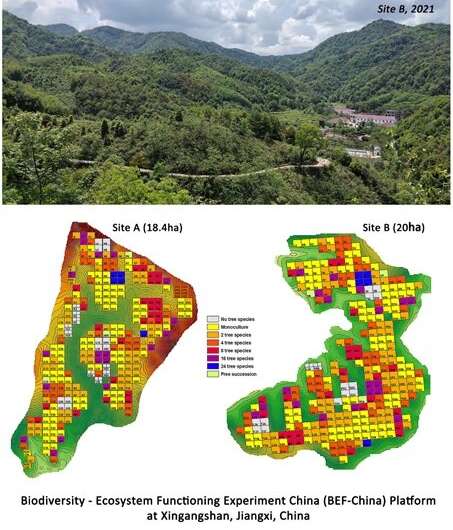Planting new forests with high functional diversity helps improve productivity

As forests age, differences in species functional traits become more important and reliable in predicting forest productivity, according to an international study led by Prof. Ma Keping at the Institute of Botany of the Chinese Academy of Sciences (IBCAS).
As part of the study, Ma and his team evaluated data from a 10-year-old planted mixed forest to determine how functional traits of species influence productivity.
The data come from BEF-China (www.bef-china.com), the world's largest forest biodiversity and ecosystem functioning experiment. It contains over 500 plots covering more than 38 ha of mountainous area.
"It is a successful demonstration case from a large biodiversity experiment that shows that functional trait ecology can work if applied in a sound way," said Prof. Ma.
Planting productive mixed forests to restore ecosystem services is an urgent global need; it refers to what kind of trees should be planted to achieve high forest productivity with mixed forests, an important ecosystem service. High productivity means high tree growth and high carbon storage, which help to reduce greenhouse gases and at the same time provide shelter and protect biodiversity.
Previous studies have shown that a mix of different species leads to higher productivity than single species forests. However, "this study emphasizes that it is not just the number of species but the specific differences in their functional traits that is important," said Dr. Franca J. Bongers, a postdoc researcher at IBCAS and first author of the study.
Especially when planted forests are older than seven years, forests with high functional diversity achieved higher productivity than forests with low functional diversity or with specifically high average functional traits.
In addition, achieving the benefit of functional differences between species is not dependent on the particular species within the community, thus making it a reliable tool for forest managers to consider.
"Reliability in predicting forest functions and services is of utmost importance in connecting restoration actions to goals," said Dr. Liu Xiaojuan, leader of the management group for the BEF-China platform.
Prof. Ma Keping, group leader and chair of the BEF-China platform, said that "restoration projects need reliable tools" to achieve the global goal of mitigating climate change and biodiversity loss.
The international collaboration to record tree growth for all ten years of growth is unique and is essential for determining yearly specific changes in forest productivity and the effects of species functional traits.
BEF-China was established and is maintained through the collective effort of scientists from China, Germany and Switzerland.
More information: Franca J. Bongers et al, Functional diversity effects on productivity increase with age in a forest biodiversity experiment, Nature Ecology & Evolution (2021). DOI: 10.1038/s41559-021-01564-3
Journal information: Nature Ecology & Evolution
Provided by Chinese Academy of Sciences




















